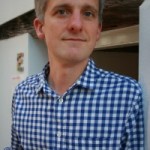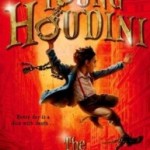
For over a year and a half, I have interviewed a wide variety of authors. One of the most fascinating aspects of this process is learning about the individual’s backgrounds. Educators and writers top the list. Simon Nicholson, the author of Young Houdini: The Magician’s Fire began his career writing and directing British theatrical productions and then later writing children’s television shows in the UK. Using this experience, Simon has created the fast paced Young Houdini series.
Anyone who leaves a comment on this blog by Sunday, January 4 , 2015 will be eligible for a random drawing. The winner will receive a copy of Young Houdini: The Magician’s Fire
Welcome Simon.
American followers of this blog may not be familiar with the British children’s television shows. Can you briefly describe some of these programs?
I’ve written some shows that have just been for the UK, but most have been for international broadcast – many are US-originated shows for Disney and Nickelodeon. Shows your readers might know would include BOB THE BUILDER, ZACK AND QUACK, PAW PATROL, TICKETY TOC and others. I’ve also written theatre shows, some for children, some for adults – including one about two murderous nannies in Soviet Russia.
In 2010, Simon published his first children’s book, The Oldmoor Orphans. This year, the chapter book, Young Houdini: The Magician’s Fire was added to his accomplishments.
What prompted you to enter the children’s book market? How did your prior background help you to become a children’s author? Did you need to take any additional steps to make the transition from your previous work to writing children’s books? (Classes, writing groups, etc.)
I never thought of it as entering the book market exactly – I just had some ideas for stories that I thought would make good books, and started writing them. My writing for the screen is a big advantage for all sorts of reasons, but mainly because it means I’ve met so many other writers (screenwriting is very collaborative). I’ve learnt an enormous amount from them – and still do – about how to put stories together.
Many writers use outlines as a starting point while others just start to write. Can you briefly describe your organizational strategy?
I don’t have a strategy, but I can more-or-less manage a plan, which is a piece of paper with the beginning, middle and end of the story written on it. This turns into a notebook, filled with thoughts about what else might happen; that then becomes a slightly thicker notebook, in which I write (longhand) my first attempts at the story. At some point, I turn on a computer and type it all out, and that’s when things start getting serious.
What are the greatest challenges that you have faced as a children’s author? If you could rewind the clock and start over, would you do anything differently?
The greatest challenge for me has to be the sheer amount of time it takes to write a story – and the way they sometimes lead you on strange convoluted paths, as you try to work them out. It always intrigues me, how the first idea for a story can occur in a matter of seconds – and then needs many months, years sometimes, to be properly explored. I’ll always be doing it though – unless I have a story I’m trying to figure out in my head, I feel alone.
Why did you choose to write a book that is marginally associated with Harry Houdini’s early years? Authors who write novels about famous people can either stick to the facts or run wild with their imagination. Why did you opt to create a character that had little in common with the notable, Harry Houdini?
I think of it as an “alternative history”. I knew the story of the real Houdini’s youth of course: how he emigrated from Budapest, Hungary to America with his family when he was just four, and grew up relatively peacefully in Appleton, Wisconsin. No records of derring-do or mystery-solving. But I had read an interesting biography (by William Kalush and Larry Sloman) in which it’s argued that the grown-up Houdini had a secret life as a spy. I started wondering; perhaps Houdini could have had another secret life too, one that happened in his childhood? What if the few facts we know of Houdini’s early years—Wisconsin, the peaceful childhood—turned out to have been a cover-up, devised later in order to conceal a far more thrilling and dangerous truth?
So I started to invent this alternative history; a series of events that didn’t happen but which might have done. Lots of writers do this: while I was drafting the books, a film called Abraham Lincoln: Vampire Hunter came out which, if they ever took it seriously, would upset a fair few historians. And Houdini himself did some playful tinkering with his life’s events; at one point he hired the famous science fiction writer H. P. Lovecraft to write to write a made-up tale about him having an adventure in Egypt, in which he investigated sinister forces beneath the pyramids. Not factually accurate, obviously – but all part of celebrating the legend of this mysterious man, which is what I’ve aimed to do too.
Even though you did not adhere to Harry Houdini’s bio, did you research the time period? In other words, did you include historically accurate general information?
Yes, I researched it! My stories are fiction, and the adventures of my young Houdini are completely made-up, but they’re grounded in the real late nineteenth century world. The first book, The Magician’s Fire, is partly set in a New York theatre, so I read a few books on the theatre world of that time. I also read some of Dion Boucicault’s melodramas, because they would have been playing in theatres when my Harry was in town, and I read books about P. T. Barnum, the great showman of the age. And throughout the writing process, I kept reading Mark Twain, the author of Tom Sawyer and Huckleberry Finn. Partly to get a sense of the historical period, but also because Mark Twain could quite possibly have bumped into Harry Houdini when he was a boy and might, I thought, have written a very good book about him…
The main characters’ friendships are refreshing. What message(s) are you providing to your young readers?
Oh, there’s no message. But Harry’s very much a real kid in this story –he has these two great friends, and he doesn’t always get along with them, but in the end they’re the most important thing in world for him. I guess that’s the point I wanted to make – that for all his amazing skills and bravery, it’s his friends that matter to him most.
Are you currently working on another children’s book? If so, can you share any information or an anticipated publication date?
The second Young Houdini book – The Demon’s Curse – is out in June 2015. I’m currently busy writing some new TV shows. Everything else is a secret!
Book Review
Later this week, I will be reviewing The Magician’s Fire
Book Giveaway
Anyone who leaves a comment on this blog by Sunday, January 4, 2015 will be eligible for a book giveaway. Simon will send the randomly selected winner an autographed copy of Young Houdini: The Magician’s Fire.
In exchange for an honest interview and review, I was sent a copy of Young Houdini: The Magician’s Fire.
Related Blogs
Q & A with Martha Seif Simpson
Sandra’s Bio
Sandra Bornstein is the author of MAY THIS BE THE BEST YEAR OF YOUR LIFE. It is available on Amazon. Sandra’s memoir highlights her living and teaching adventure in Bangalore, India. She is a licensed Colorado teacher who has taught K-12 students in the United States and abroad as well as college level courses. Sandra is married and has four adult sons. The memoir was a finalist in the Travel category for the 2013 Next Generation Indie Book Awards, the 2013 International Book Awards, the 2013 National Indie Book Excellence Awards, the 2013 USA Best Book Awards, and received an Honorable Mention award in the Multicultural Non-Fiction category for the 2013 Global ebook Awards.

Leave a Reply
You must be logged in to post a comment.